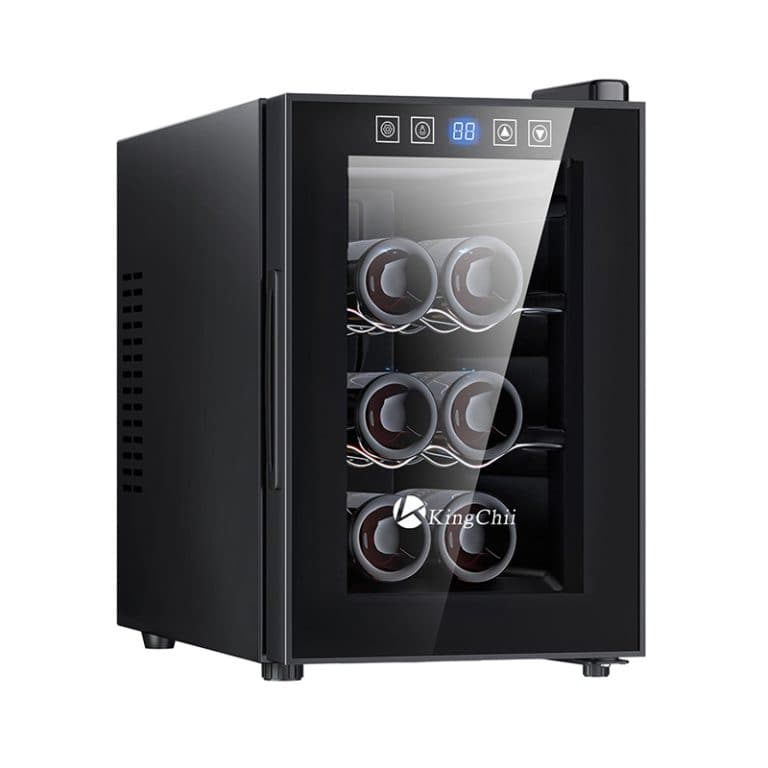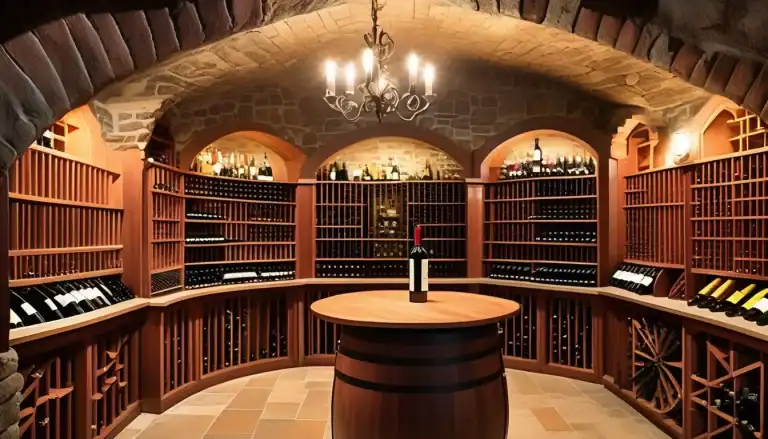Wine aging is a fascinating journey in which flavors evolve, tannins soften, and complexity deepens over time.
Proper cellaring allows wines to reach their full potential. One way to achieve this is by using a wine refrigerator. In this article, we will explore how to use a wine fridge in cellaring – let’s get started.
Welcome to Didi Somm and Cheers!
Important Notice: The information in this article is for general and public information purposes only. It solely reflects Didi Somm’s or his Staff’s opinion, and no responsibility can be assumed for errors or omissions in the service’s contents. For details, please check the Disclaimer at the bottom of the homepage.
Key Takeaways
Precise Temperature Control
Optimal Humidity Levels
Horizontal Storage for Corked Bottles
Vibration Reduction

What is Wine Cellaring?
Wine cellaring refers to the deliberate practice of storing wine under controlled conditions to allow it to mature and develop over time. The goal is to enhance the wine’s flavors, aromas, and complexity.
Short-Term vs. Long-Term Cellaring:
Short-Term Cellaring involves storing wine for up to 5 years.
The purpose is to enjoy vibrant, fruity, and expressive wines at their youthful best.
Examples: Many white wines, lighter reds, and some rosés are best consumed relatively young.
Long-Term Cellaring involves aging wine for 5 years or more.
The purpose is to allow wines (exceptional wines only) to develop complexity, softer tannins, and secondary flavors (such as earthiness, tobacco, spices, etc.).
Examples: High-quality reds (like Bordeaux, Barolo, and aged Rioja) benefit from long-term cellaring.

Precise Temperature Control
Benefit: A wine refrigerator provides consistent temperature control, crucial for aging. Unlike regular refrigerators, which fluctuate in temperature, wine fridges maintain a stable environment.
Ideal Temperature: Set your wine fridge to 50°F to 59°F (10°C to 15°C). This range ensures gradual maturation without premature aging or spoilage.
Optimal Humidity Levels
Benefit: Wine refrigerators maintain humidity levels between 60% to 70%. This prevents corks from drying out and maintains an airtight seal.
Why Does It Matter? Dry corks let air seep into the bottle, leading to oxidation and undesirable flavors.
Protection from Light and Heat
Benefit: Wine is sensitive to light and heat. Wine fridges are designed to shield bottles from harmful UV rays and excessive warmth.
UV Protection: Many wine fridges have UV-resistant glass doors or solid doors to prevent light exposure.
Heat Avoidance: Keep your wine fridge away from direct sunlight and heat sources.
Horizontal Storage for Corked Bottles
Benefit: Wine fridges offer horizontal shelving, allowing you to store bottles on their sides.
Why It Matters: Storing bottles horizontally keeps the cork moist, preventing it from shrinking or allowing air to enter. An intact cork ensures proper aging.
Vibration Reduction
Benefit: Wine fridges minimize vibrations.
Impact of Vibrations: Constant movement can disturb sediment in the bottle, affecting flavor and texture.
Wine Collection Organization
Benefit: Wine fridges help you organize your collection effectively.
Inventory Tracking: Label bottles with vintage, varietal, and purchase date details. Create a system to manage your wines.
Peak Timing: Set reminders for specific wines’ peak maturity.
Enjoying Aged Wine
Benefit: A well-aged wine is a reward for patience.
Timing: Determine when a wine is ready to drink based on its aging potential. Whites and lighter reds are best consumed within 3-5 years, while fuller-bodied reds can age longer.
Decanting: When opening an aged bottle, consider decanting to allow flavors to breathe.
Choosing the Right Wine Fridge
What to Consider When Selecting a Wine Fridge?
Types of Wine Refrigerators: Thermoelectric vs. Compressor-Based
Thermoelectric Wine Refrigerators:
Energy Efficient: These wine refrigerators have fewer moving parts and consume less power. Environmentally friendly and cost-effective.
Quiet Operation: Minimal noise due to reduced internal movement. Ideal for quiet spaces like kitchens or living rooms.
Vibration-Free: Perfect for aging wine without disturbing sediment. Stable conditions promote better flavor development.
Small Capacities: Suitable for smaller collections or occasional wine drinkers.
Heat Sensitivity: Not ideal for warm environments; performance may suffer in high ambient temperatures.

Compressor Wine Refrigerators:
Powerful Cooling: Larger capacity and faster cooling. Suitable for serious collectors or those with extensive wine collections.
More comprehensive Temperature Range: Can handle both short-term storage and long-term aging.
Built-In Options: Often used for kitchen installations. Blends seamlessly with cabinetry.
Not as Quiet: Generates more noise due to compressor operation. Best placed in less noise-sensitive areas.
Versatility: Holds various bottle sizes and accommodates diverse wine types.
Wine Fridge Accessories
Wine Thermometers:
Wine thermometers help you monitor the temperature inside your wine fridge. Attach the thermometer to a shelf or hang it inside the fridge. Look for a thermometer with a range suitable for wine storage (typically around 50°F to 59°F).
Hygrometers:
Hygrometers measure humidity levels. Position the hygrometer near the bottles or on a shelf. Maintain humidity between 50% and 70%.

Shelving Options
Wooden Wine Racks: The Classic Choice, adding elegance to your wine storage area. Choose from various sizes and configurations to fit your space. They are ideal for horizontal storage of corked bottles.
Metal or Wire Racks: Metal or wire racks offer a sleek, contemporary design. Their modular systems allow you to custom-build your wine storage and add more modules as your collection grows. You can combine wood, metal, and glass elements for a unique look.
Pro Tip: For detailed information about wine racking, I recommend checking the Wine Racks America website.
Additional Tools and Accessories
Wine Pourers and Aerators: Pourers and aerators improve wine taste by allowing controlled oxygen exposure during pouring.
Wine Vacuum Sealers: Vacuum sealers remove excess air from opened bottles, extending their shelf life.
Wine Glass Charms or Tags: Use charms or tags to label wine glasses during wine tastings.
Budget-Friendly Wine Fridges
You don’t have to break the bank. Even budget-friendly wine fridges can provide adequate storage and temperature control. We recommend the following options:
Compact Countertop Wine Coolers: These units can hold around 6 to 12 bottles and are ideal for those with limited space or a modest wine collection. Look for thermoelectric models that are energy-efficient and quiet.
Single-Zone Freestanding Wine Fridges: These are designed for simplicity and affordability and hold up to 24 bottles. They are the perfect solution for beginners or casual wine drinkers. They focus on functionality rather than fancy features, offering adjustable temperature settings and removable shelves.
Balancing Quality and Cost – a crucial evaluation: While affordability matters, don’t compromise on quality. Look for reputable brands, like NutriChef, Ivation, and Koolatron, that are known for their reliable performance. Read reviews and compare features before making a decision.
Energy Efficiency: Thermoelectric wine fridges are often more efficient than compressor-based ones.
Long-Term Considerations: Consider the fridge’s lifespan. Spending a bit more upfront on a durable unit may pay off in the long run.
Maintenance and Care
Benefit: Proper maintenance ensures consistent conditions.
Regular Cleaning: Keep the wine fridge clean and free from dust.
Check Seals: Ensure the door seals are intact to maintain air tightness.
FAQ – How to use a Wine Fridge
Are wine fridges environmentally friendly? – Wine fridges are generally not very eco-friendly. They continuously consume electricity to maintain precise conditions, impacting energy usage. However, some newer models are designed with energy-saving features.
Can you put red wine in a wine fridge? – Absolutely! A wine fridge is perfect for storing red wine. It keeps it at the right temperature (around 55°F or 13°C) for aging and enjoyment.
Can you put a wine fridge in a cellar? – Yes, you can. It’s a great way to create a controlled environment for specific wines.
How long can you keep wine in a wine fridge? – Wine fridges are ideal for both short-term and long-term storage. You can keep wine in a wine fridge for years, allowing it to age gracefully.
Can a wine fridge be used as a regular fridge? – While technically possible, it’s not recommended. Wine fridges are optimized for wine storage, not everyday items. Regular fridges are better for general food storage.
- What’s the difference between a Kitchen Fridge and a Wine Fridge? – Temperature: Wine fridges maintain a specific wine-friendly temperature, whereas kitchen fridges have temperature ranges. Humidity: Wine fridges control humidity for cork preservation, which regular fridges don’t prioritize. Design: Wine Fridges often have wooden shelves and UV-resistant glass doors, enhancing aesthetics and protection.
- How do you use a wine fridge in the garden? Place it in a shaded spot to avoid direct sunlight. Ensure it’s on a stable surface to prevent vibrations.
Conclusion
Given the variety of wine refrigerator models and their versatility, cellaring is simplified with these refrigerators, allowing you to focus on enjoying the transformation of your favorite wines.
Whether you’re a novice collector or a seasoned enthusiast, a wine fridge is invaluable for preserving and enhancing the quality and value of your wine collection.
For your reference, the latest articles by “Didi Somm” include:
- The Art of Wine Storage: 30 Best Tips to Preserve Your Wines
- Best Wine Refrigerators in 2024
- How to Choose a Wine Cabinet? – 7 Essential Questions Answered
- From Wood to Stone – The Best 5 Wine Cabinet Materials for You
- How to Organize a Wine Cellar? – 9 Best Tips to Organize Your Wine Collection
Important Notice: The information in this article is for general and public information purposes only. It solely reflects Didi Somm’s or his Staff’s opinion, and no responsibility can be assumed for errors or omissions in the Service’s contents – for details, please check the Disclaimer at the bottom of the homepage.





